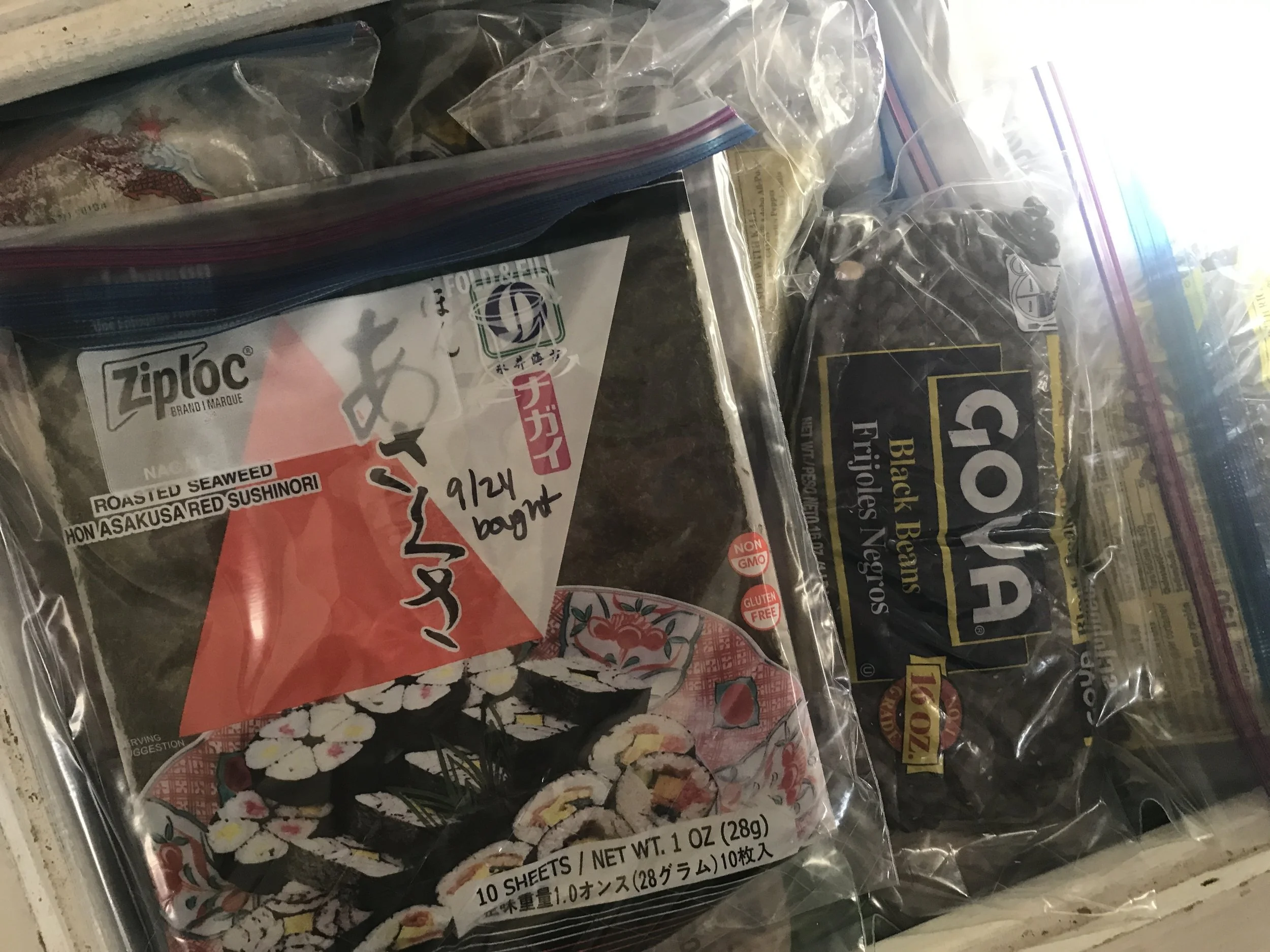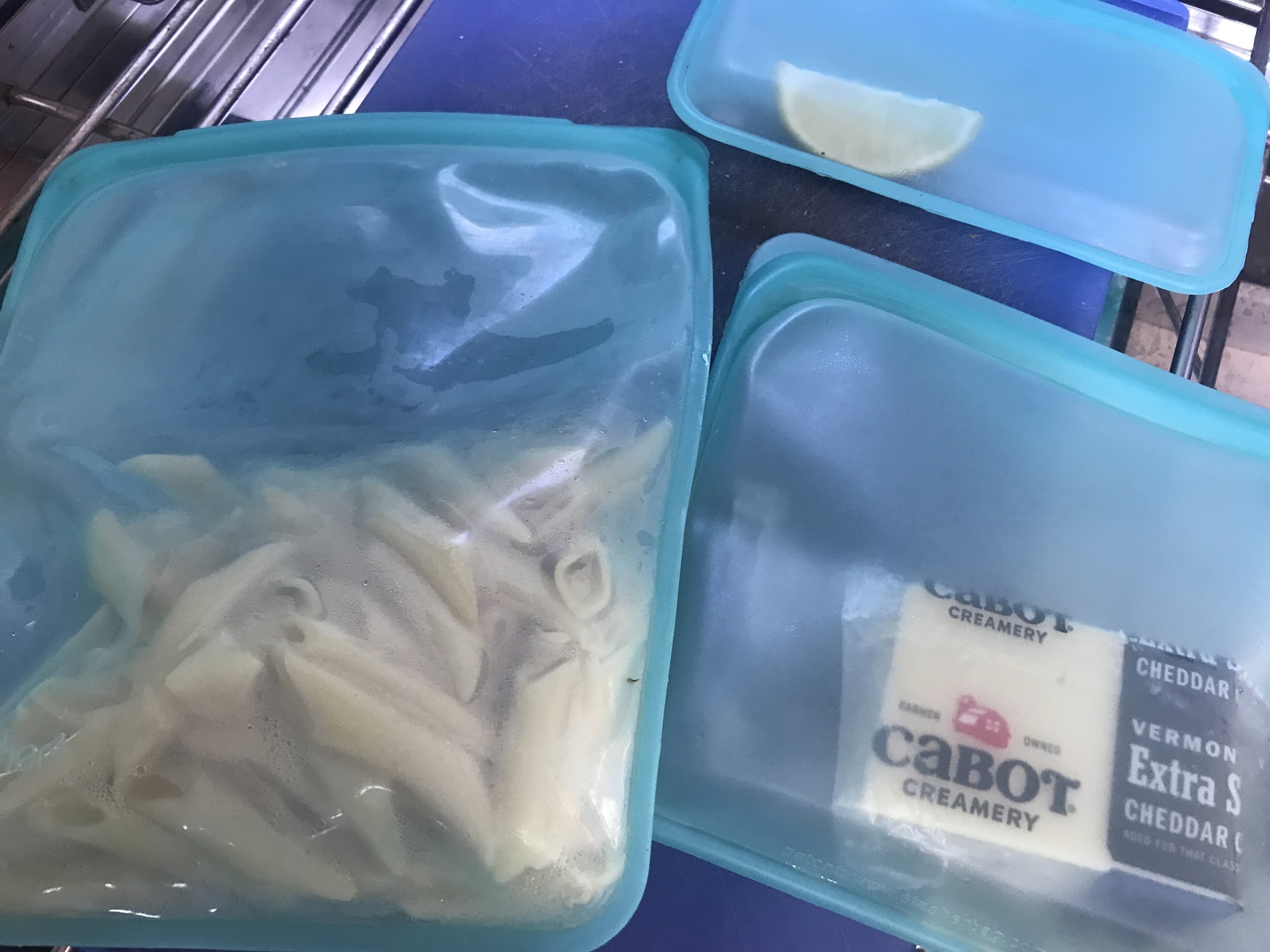Plastic Bag Primer
Er, it’s the reusable, zipper bags I’m talking about here.
“Have you ever tried those silicone reusable bags instead of plastic ones?” came the question over lunch the other day at the SSCA GAM. I’d been waxing poetic (not really, maybe just being overly enthusiastic) about Ziplocs, and the person wanted to hear my thoughts on the other kind. Yes, we use those too - and it made me think a post about our bags might be helpful.
On board Calypso, we’ve got plastic zipper bags of 3 sizes, plus additional “vacuum seal” bags and those silicone ones. Each has its own specific use, and we find each size to be essential.
A note: all of these are reused, over and over again. Turn a plastic bag inside out, wash it with soap and water, and hang to dry. They can be reused a dozen or more times, though they get less reliable as time goes on. Even the ones that are no longer waterproof can be used to separate out components of a project. We keep fresh, never-used bags in a different bag than the ones that are on multiple life duty. The only bags I don’t reuse are ones that have held raw chicken. (unless I’m using them for non-food use)
Weirdest looking chicken ever
The ZIPLOC bags. Yes, I’m brand-conscious. The thicker ones labeled “freezer”, press-together ones are what we carry. We’re so serious about the quantities that these are purchased at Costco. Why brand name? They do a better job in my experience with actually staying closed, plus don’t deteriorate as fast when being washed repeatedly. Why freezer? They’re thicker, with a double seal instead of a single one. It’s worth the premium.
Quart sized ones are great for smaller stuff. Variously these hold fasteners, small quantities of line, rigging shackles in a larger rigging box. You get the general idea. They also serve as phone protectors when going ashore or as a “cruisers wallet”; I tuck quarters for laundry into a quart size bag so they’re easy to find or take ashore with the laundry collection. We’ve been known to hoist a phone up the mast in a quart-sized ziploc when needed to get better cell signal.
Gallon sized ones are the workhorse of the bunch. Every bag of dry provisions on the boat is first labeled with the date, then tucked into a gallon sized bag. Any rice, pasta, dried bean, bag of crackers, pancake mix - removed from any cardboard box and put into its own ziploc before being stashed in the appropriate locker. These are the easiest bags to reuse, of course, because they’re clean clean clean. Why put items that come in their own plastic bag into yet another bag? What happens if there’s a rip in the original packaging? What happens if there’s a unforeseen leak, either of water finding its way into the locker or if another item punctures or leaks? Those ziploc bags are fabulous!
Dry goods in gallon sized ziplocs, starboard side settee middle locker.
2-gallon sized bags, unfortunately not available at Costco, and unfortunately often only available as the zipper-style, are indispensable. When I find them, I buy 5 or more boxes. They are not common, so keep your eyes out! These are used to protect larger dry provisions (5 pound bags of flour, for example). We also use them as the double-bag for boxes of wine or rhum. Those spirits are removed from the cardboard they come in, and the bag is placed into the ziploc with the label so we remember what it is in there. 2-gallon size bags also serve to stash small pieces of clothing, up to and including spare cold-weather gear.
2 gallon ziplocs are great for sandpaper
Then we have vacuum seal bags. After a little trial and error, we’ve settled on the “as seen on TV” ones that come in multiple sizes. The amount of air that vacuum pump can suck out is incredible! Watching a sleeping bag go from unwieldy round to pancake flat is kind of awe-inspiring. Just how much room are we wasting storing air?? The one thing to watch out for is that that pancake is quite stiff, making it a bit challenging to store the packages since they don’t conform to the odd spaces that sometimes are the reality of lockers on board.
Next up is the silicone bags. We do carry a reasonable number of these, which we use primarily for leftovers. The one in heaviest rotation is a snack sized one that is perfect for holding cut limes and lemons! They’re heavy and clean nicely, though the corners are difficult to clean super well since they don’t turn completely inside out. You also need to be careful of food getting into the press closure. I’ve tried the ones where you slide a closure bar over the bag and found them frustrating; these bags are easy to close completely. We’ve got large ones that can hold almost a pound of cooked pasta, medium ones (I think they’re called the sandwich size), and the snack size ones. They are too expensive (and likely too thick as well) to use in the quantities we need for general provision storage. I will say that silicone gets gummy and sticky over time, so we’ll see how well these hold out. If you have good ideas on cleaning them to prevent such deterioration, please share!
3 different sizes of silicone bags, all housing leftovers of some sort.
Plastic isn’t great. Being mindful of how and when you use it, and reuse reuse reuse instead of just buying into the “single use” mantra is one way to lessen the damage wrought.




